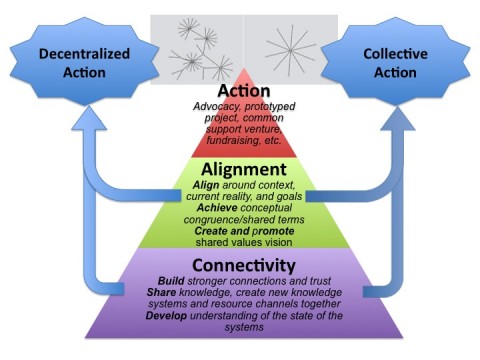Networks for Change: Skill, Will, Attitude and Structure
September 10, 2015 2 CommentsA couple of weeks ago I joined a panel of presenters on a webinar hosted by Johns Hopkins’ Center for a Livable Future focused on collective impact and network building for food policy councils. Other panelists included Ellen Kahler from Vermont Farm to Plate Network, Jennifer Obadia from Health Care Without Harm, and Whitney Fields from Indianapolis Food Council. My role was to provide an overview of collective impact, giving credit to FSG and the Collective Impact Forum for codifying and advancing research and practice in this arena, as well as network building principles as applied to collaborative efforts to realize more local, just and sustainable food production, distribution and access.

As part of the presentation, I shared the framework above, adapted from the work of Peter Plastrik and Madeleine Taylor (co-authors of the book Connecting to Change the World), which looks at three different and significant ways that network activity can create value and contribute to change. One is in this domain of connectivity, where people build relationships and trust and share information. Another is alignment, where network participants align around some common sense of destination or shared value. And the last is action, where people formally coordinate around some kind of desired outcome (policy change, new venture, fundraising).
While action is what often draws us to net work, I pointed out that there is great power in building connections that lead to the kind of change we had not anticipated – what is often called emergence. That is, in many collective efforts, focus is primarily on formally organized and planned activity around some kind of officially selected goal. What interests me, and where I think tremendous untapped potential resides, is in the emergent forms of value that arise on their own when people and organizations are more connected and aligned. See, for example, the Barr Fellows example below and in the case study – “Networking a City.”
Social Capital & Emergence from Barr Foundation on Vimeo.
It was interesting to then listen to the other panelists describe their respective initiatives and experiences. As they talked, I jotted down a few notes, outlining some of the key elements to effective collaboration for social change that were explicit or implicit across their comments:
- Skill – Collaboration is not necessarily a natural or comfortable act to everyone, even when they know it is a necessity. This is especially so when working across certain lines of difference (identity, sector, strategic approach). Behind many effective collaborative efforts is a story of procedural and relational skillfulness that is rarely told. More on this here – Facilitative Leadership for Net Impact.
- Will – Skill alone doesn’t do it, especially when the going gets tough. Will is the drive to push through or knowing when to step back and “hold the space,” to stay committed during the bumps, and (as well like to say at IISC) to learning what to do when we don’t know what to do. This includes remaining committed to diversity, inclusion and equity that is foundational to social change.
- Attitude – Most effective collaborative efforts benefit from champions, people and parties who hold down the commitment to the collective and who lead with and model a spirit of generosity, and who demonstrate belief in the possibility of win-win and abundance-creating solutions.
- Structure – Every collaborative effort depends upon some form of structure, but what this is depends upon context and the nature of the effort. Ideally we are not perpetuating burdensome structures that frustrate and drive people away, but also not leaving things so fluid that people float away. And ultimately structure must evolve as the needs and nature of the work change.
What would you add? What is foundational to your collective work for change?


2 Comments
Hi to every one, it’s truly a nice for me to go to see this web
page, it consists of helpful Information.
It’s going to be ending of mine day, but before end I am reading this wonderful post to improve my knowledge.